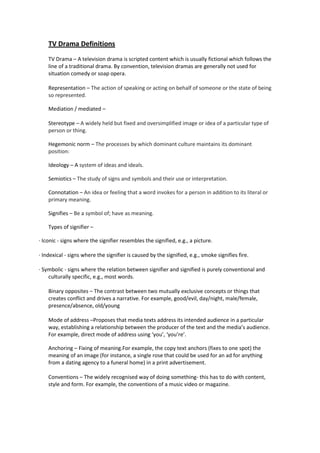Tv Drama Definitions
- 1. TV Drama Definitions TV Drama â A television drama is scripted content which is usually fictional which follows the line of a traditional drama. By convention, television dramas are generally not used for situation comedy or soap opera. Representation â The action of speaking or acting on behalf of someone or the state of being so represented. Mediation / mediated â Stereotype â A widely held but fixed and oversimplified image or idea of a particular type of person or thing. Hegemonic norm â The processes by which dominant culture maintains its dominant position: Ideology â A system of ideas and ideals. Semiotics â The study of signs and symbols and their use or interpretation. Connotation â An idea or feeling that a word invokes for a person in addition to its literal or primary meaning. Signifies â Be a symbol of; have as meaning. Types of signifier â · Iconic - signs where the signifier resembles the signified, e.g., a picture. · Indexical - signs where the signifier is caused by the signified, e.g., smoke signifies fire. · Symbolic - signs where the relation between signifier and signified is purely conventional and culturally specific, e.g., most words. Binary opposites â The contrast between two mutually exclusive concepts or things that creates conflict and drives a narrative. For example, good/evil, day/night, male/female, presence/absence, old/young Mode of address âProposes that media texts address its intended audience in a particular way, establishing a relationship between the producer of the text and the mediaâs audience. For example, direct mode of address using âyouâ, âyouâreâ. Anchoring â Fixing of meaning.For example, the copy text anchors (fixes to one spot) the meaning of an image (for instance, a single rose that could be used for an ad for anything from a dating agency to a funeral home) in a print advertisement. Conventions â The widely recognised way of doing something- this has to do with content, style and form. For example, the conventions of a music video or magazine.
